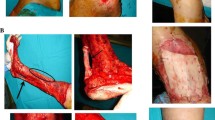Abstract
At present, one of the treatments of choice for closure of full-thickness skin loss is to use a cultured epidermal autograft when skin loss is extensive. In this study, we investigated a simple method of processing frozen surplus skin to produce an acellular, structurally intact, dermal matrix. First, the acellular dermal matrix prepared from normal human skin (ADM) we processed was observed using a transmission electron microscope and a scanning electron microscope. The matrix maintained the basement membrane complex and the extracellular matrix structure of the dermis despite frozen skin being used. Next, using an animal model, we transplanted the ADM and Pelnac, which is used as a contrast in full-thickness wounds onto nude rats. The dermal matrix supported fibroblast infiltration and neovascularization. These results suggest that skin processed by our simple method has the potential to be used as a dermal template together with the cultured epidermis in the closure of full-thickness wounds.
Similar content being viewed by others
References
Blanck G, Lok M, Kok K, et al.: Gamma-interferon induction of HLA class II mRNAs in dermal fibroblasts studied by RNAes protection analysis. Hum Immunol29:150, 1990
Brown JB, Fryer MP, Ronda UP, et al: Post mortem homografts as biological dressings for extensive burn and denuded areas. Ann Surg138:618, 1953
Burke JF, Yannus IV, Quinby WC, et al.: Successful use of a physiologically acceptable artificial skin in the treatment of extensive burn injury. Ann Surg194:413, 1981
Burke JF: Observation on the development of an artificial skin. Presidential address, 1982 American Burn Meeting. J Trauma23:543, 1983
Castagnoli C, Stella M, Magliacani G, et al: Anomalous expression of HLA class II molecules on keratinocytes and fibroblasts in hypertrophic scar consequent to the thermal therapy. Clin Exp Immunol82:350, 1990
Chetty BV, Boissy RE, Warden GD, et al.: Basement membrane and fibroblast aberration in blisters at the donor, graft and spontaneously healed sites in patients with burns. Arch Dermatol128:181, 1992
Compton CC, Gill JM, Bradford DA, et al.: Skin regenerated from cultured epithelial autografts on full-thickness burn wounds from 6 days to 5 years after grafting. A light, electron microscopic and immunohistochemical study. Lab Invest60:600, 1989
Cuono CB, Langdon R, Brichall N, et al: Composite autologous-allogenic skin replacement: Development and clinical application. Plast Reconstr Surg80:626, 1987
Cuono CB, Langdon R, McGuire J: Use of cultured epidermal autografts and dermal allografts as skin replacement after burn injury. Lancet1:1123, 1986
Dagalakis N, Flink J, Staskielis P, et al: Design of an artificial skin. III. Control of pore structure. J Biomed Mater Res14:511, 1980
Erlich HP, Trelstad RL, Fallon JT: Dermal vascular patterns in response to burn or freeze injury in rat. Exp Mol Pathol34:281, 1981
Grabosch A, Rokes H: Neopterin as parameter of cellmediated immunity response in thermally injured patients. Burns18:113, 1992
Hiramoto M, Nishihata K, Azuma K, et al: Using a new artificial skin (GM901) for full-thickness wound defects. Base Clinic27:643, 1993
Hirayama S: Clinical use of artificial skin (SS-D). Ther Res13:2005, 1992
Ishida H, Kumagai N, Tanabe H, et al.: Clinical study of artificial skin (SS-D). Base Clinic26:1574, 1992
Koide M, Osaki K, Konishi J, et al.: A new type of biomaterial for artificial skin: Dehydrothermally cross-linked composites of fibrillar and denatured collagens. J. Biomed Mater Res27:87, 1993
Lamke LO: The influence of different “skin grafts” on the evaporative water loss from burns. Scand J Plast Reconstr5:82, 1971
Langdon RC, Cuono CB, Birchall N, et al.: Reconstitution of structure and cell function in human skin grafts derived from cryopreserved allogeneic dermis and autologous cultured keratinocytes. J Invest Dermatol91:478, 1988
Livesey SA, Hernon DN, Hollyoak MA, et al: Transplanted acellular allograft dermal matrix. Transplantation60:1, 1995
Lovenz HP, Adzick NS: Scarless skin wound repair in the fetus. West J Med159:350, 1993
Marshall L, Ghosh MM, Boyce SG, et al.: Effect of glycerol on intracellular virus survival; Implications for the clinical use of glycerol-preserved cadaver skin. Burns21:356, 1995
Matsuda K, Suzuki S, Issiki N, et al.: Two layers of artificial skin that is refrozen and dried. Burns17:77, 1991
Morita S, Takasawa H, Matsuda K, et al.: Re-freeze dried bilayers artificial skin. Proc 1st Far-East Symp Biomed Mater, 1993, pp 109–110
Osaki K, Konishi A, Ikegami K, et al.: New trial use of “artificial skin.” Artif Intern Organs20:497, 1993
Oura T, Sugihara H, Nakamura Y, et al.: Clinical use of Terdermis as dermal substitute for serious dermal defect cases. Base Clinic28:114, 1994
Oura T, Honda K, Nara T, et al. Experience of using dermal substitutes: Neo-Matrix for full-thickness dermal defect wounds. Pharmacol Ther23:1635, 1995
Rowden G, Lewis MG, Sullivan AK: Ia antigen expression or human epidermal Langerhans cells. Nature (Lond)268:247, 1977
Sakurai M, Takami Y, Tanaka H, et al.: Study of dermal substitutes taking process; Difference between an acellular dermal matrix and an artificial skin. 23th Japan Burn Society General Meeting, Excerpts, 1997, p 124
Sedmak DD, Orosz CG: The role of vascular endothelial cells in transplantation. Arch Pathol Lab Med115:260, 1991
Suzuki S, Issiki N: Clinical studies of using re-frozen and dried 2-layer artificial skin (GM901). Plast Reconstr Surg36:479, 1993
Takami Y, Kubota J, Ogo K: Factors that stimulate taking in artificial skin grafts. 6th Japan Plastic and Reconstructive Surgery Society Basic Meeting, Excerpts, 1997, p 58
Yannus IV, Burke JF: Design of an artificial skin. I. Basic design principles. J Biomed Master Res14:65, 1980
Yannus IV, Burke JF, Gordon PL, et al.: Design of an artificial skin. II. Control of chemical composition. J Biomed Mater Res14:107, 1980
Yannus IV, Burke JF, Warpehoski M, et al.: Prompt, longterm functional replacement of skin. Trans Am Soc Artif Intern Organs27:19, 1981
Yannus IV, Burke JF, Orgill DP, et al.: Wound tissue can utilize a polymeric template to synthesize a functional extension of skin. Science215:174, 1982
Author information
Authors and Affiliations
Rights and permissions
About this article
Cite this article
Mizuno, H., Takeda, A. & Uchinuma, E. Creation of an acellular dermal matrix from frozen skin. Aesth. Plast. Surg. 23, 316–322 (1999). https://doi.org/10.1007/s002669900292
Issue Date:
DOI: https://doi.org/10.1007/s002669900292



